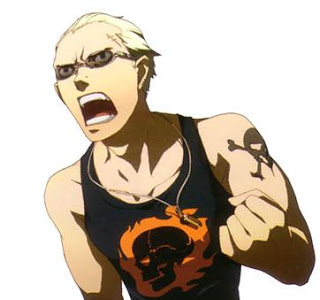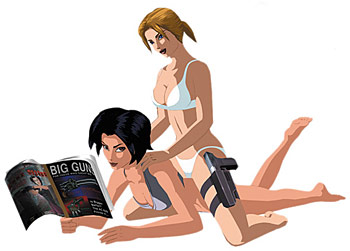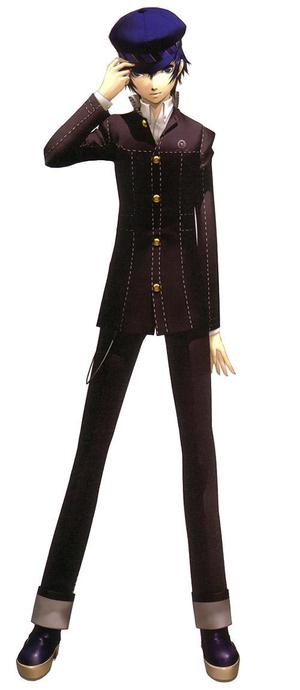This post has not been edited by the GamesBeat staff. Opinions by GamesBeat community writers do not necessarily reflect those of the staff.
Editor’s Note: I actually interviewed Persona 4 director Katsura Hashino and art director Shigenori Soejima for a 1UP Afterthoughts feature late last year, and I found it interesting that the one question they declined to comment on was a query relating to Kanji Tatsumi’s sexuality. I took that to mean that it’s pretty much up to the player to determine where Kanji’s coming from, and that if players want to interpret him as a gay character, they can. (Much more after the jump.) -Fitch

Warning: this post contains minor spoilers.
While I’m fairly late to the party, it took me a while to finally finish Persona 4 and develop a better understanding of the various issues surrounding Kanji Tatsumi and his inability to reconcile the various aspects of his identity.

The article that has sparked the most talk on the subject is Samantha Xu’s Opinion: Sexuality and Homophobia in Persona 4. Xu’s article posits that the ambiguity of Kanji’s sexuality is due, at least in part, to the fluidity of sexual definition in Japanese society:
In Kanji’s case, remaining ambiguous and undeclared about his sexuality is not necessarily a rejection of its existence or the developers displaying homophobia, but rather as a comment on homosexuality in a greater Japanese social context.
In an American context, Kanji falls into the “he doth protest too much” cliché of the man who asserts his heterosexuality in order to hide his homosexual desires or tendencies — and perhaps it’s easy to see how this would work as a comment on Japanese society as well.
 However, this conclusion is somewhat problematic when one considers the greater context of the Shin Megami Tensei: Persona franchise. Jun Kurosu was the first openly gay character in the Persona line, appearing in the Japan-only Persona 2: Innocent Sin. Not only was Jun gay, but he was a possible love interest for the main character, who can choose among Jun and two other female characters.
However, this conclusion is somewhat problematic when one considers the greater context of the Shin Megami Tensei: Persona franchise. Jun Kurosu was the first openly gay character in the Persona line, appearing in the Japan-only Persona 2: Innocent Sin. Not only was Jun gay, but he was a possible love interest for the main character, who can choose among Jun and two other female characters.
Kanji’s gay identity aside, the franchise has already “gone there” and has had an openly gay character that the player can “date.” The designers already made a comment on homosexuality by giving the player this option back in 1999.
And while Xu was unable to reach Atlus Japan for comment, the DoubleJump-published Persona 4 strategy guide has a two page Q&A section that includes some interesting revelations. Unfortunately, the guide doesn’t credit a specific individual from Atlus for the responses, so we can only assume that it was one of the principal designers or scenario writers.
On page 303 of the guide, the question is raised why Innocent Sin is the only game in which the main character can date another male. The Atlus designer responds that the relationship was an attempt to attract fujoshi or “female Japanese fans of anime and comics where they value romantic relationships between fictional male characters, in a different way than in real-life gay culture” Indeed, the designer readily admits that Jun Kuroso was a calculated attempt to try to “satisfy those fans.”
Given the underground Japanese yaoi and yuri subculture, found specifically in the “geek” cross-section of anime, manga and games, it seems somewhat unnecessary to be subtle with references to homosexuality. The developer readily admits that they were actually pandering to a specific audience to try to draw them into the game. In fact, one might suggest that it is the Japanese equivalent of Fear Effect 2, albeit in a much more subtle form than this:

That a game in the franchise published nearly a decade ago has already tread into this territory suggests that Kanji might not have been designed as a comment on contemporary sexual politics in Japan. Or, if Kanji is meant to be a cipher to Japanese society, then Jun Kurosu is just as important a touchstone — if not more so.
But we can also hear from the developers themselves. Page 302 of the guide reveals their intentions when they created both Kanji and Naoto:
“Juvenile punks” and “boy detectives” are stereotypes in Japanese anime and comics…. But of course, doing straight versions of them would be boring and prevent the players from being “pleasantly surprised,” so we gave them mental weaknesses completely counter to their appearances.
Kanji’s proclivity for arts and crafts, specifically sewing, isn’t an attempt to feminize or “queer” the character, but rather Atlus’ attempt to destabilize a common stereotype found in Japanese fiction. Even if we are to subscribe to the “death of the author” school of thought, I believe it would be completely disingenuous to disregard authorial intent. While we might choose to see Kanji as a gay character, he wasn’t necessarily designed to be one.
In this context, I would posit another reading of the character. Kanji isn’t gay, but social definitions of gender are so rigid — in both Japan and in America — that the only form of self-identification that he can find is within the box that other people have placed him. Or, to put it more simply, he is taught that a straight man would never learn how to sew, so he must be gay. He acts out in an aggressively “masculine” manner not because he wants to prove that he is straight, but because that is the only outlet for masculinity of which he is aware.
We do it all the time in America. The most famous cultural example would be the television series Frasier.

Are Frasier and Niles Crane gay characters because they prefer opera to football or Bordeaux to Budweiser? Or do they simply exert cultural values that differ from accepted heterosexual depictions of men, and are thus uncategorizable? They might be “queer” characters, but it would be difficult to accept that they are gay characters.
Of course, there’s also one other outstanding issue that I find much more problematic with the discussion of queerness in Persona 4 — the lack of any discussion concerning the aforementioned “boy dectective” Naoto Shirogane.

I think this is probably because of how sexuality is defined in the West, where transgender and transsexual identity is very often “forgotten” when discussing queer identity. Yes, Kanji might like to sew teddy bears and other stuffed animals, but Naoto cross-dresses in order to self-identify as a man. Indeed, she is referred throughout the game as “Naoto-kun” and not “Naoto-chan” or even “Naoto-san”, showing that she not only willingly accepts her categorization as male, but that the characters are equally complicit in her desire to be a “man.”
I can only wonder why it is that we can accept that Naoto is struggling to find a place for herself in a society with rigid gender definitions and not categorize her as gay or even queer. While the boys in the game crossdress for the “Miss” Yasogami High beauty pageant, I’d like to believe that her struggle with gender identity is endemic to her character and not a mere affectation. If anything, Naoto’s character is more destabilizing than Kanji’s in the realm of queer identity politics — and it’s telling that people have largely ignored her role in the game and focused on Kanji’s sexuality instead.
I do believe that a discussion of sexuality and queerness in Persona 4 is fruitful and I praise Samantha Xu’s article for raising the issue in the first place. Very often, issues of race, gender, and sexuality are overlooked in games because we’re focused on whether or not they’re running at 60 frames per second or if the matchmaking’s broken, so I’m happy whenever I see an article like Xu’s on a “major” website. But in the case of Persona 4, I think we can — and should — dig much deeper.
